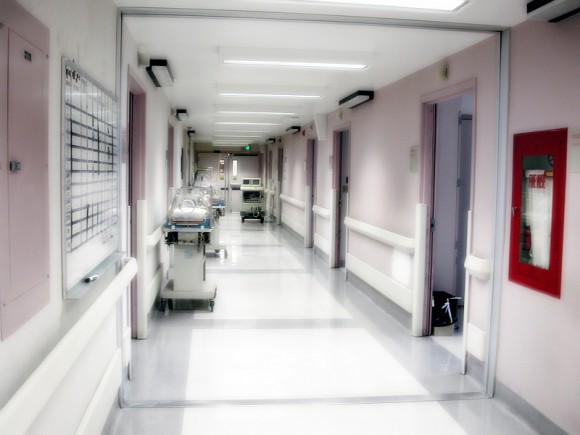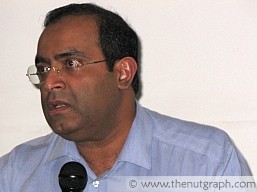
IN 2008, Malaysia spent about RM35 billion on healthcare, more than half of it in the private sector. Malaysian Medical Association (MMA) president Dr David Quek says RM18.8 billion was spent in the private sector that year. Of that amount, Malaysians forked out RM10.8 billion from their own pockets for private healthcare. They can expect to fork out more in the years to come.
This may account for health director-general Tan Sri Dr Mohd Ismail Merican’s comments, in early June 2010, about private hospitals’ “exorbitant fees”. Merican said price revisions were necessary, and he would meet the MMA to develop a comprehensive and acceptable fee schedule.
But why is the government attempting to curb private healthcare costs when there is supposed to be a readily available and more affordable public healthcare system? Shouldn’t the government focus on improving the public healthcare system, making it an automatic price check on private healthcare? After all, why would someone pay RM30,000 for a heart bypass if they could get quality care for minimal cost at a public hospital?
Political, economic ramifications
Universiti Malaya political economist Associate Professor Dr Terence Gomez says declining standards in government sectors have led the middle class to look for ways to bypass the public system.
“The promotion of medical insurance has led to private healthcare being more affordable for the middle class,” he tells The Nut Graph in a phone interview. Rising private healthcare costs, however, have led to higher insurance premiums, coupled with lower coverage.
Gomez says escalating private healthcare costs is therefore a political issue as well as an economic one. “The government faces a potential backlash from the middle class who don’t want to pay huge insurance premiums and yet are not willing to return to the public health system,” he says.
“This is an issue of concern for the [Barisan Nasional] government, which is already facing declining middle-class support.”
Controlling businesses

But is capping private healthcare fees a sustainable way to ensure affordable and quality healthcare for all Malaysians?
Sunway Medical Centre chief executive officer Dr Chong Su Lin says running a hospital business is not as lucrative as imagined. “Our nett profit margins are only about 5%,” she tells The Nut Graph in an interview. “That is, if we do make any profit in any given year.”
Merican confirms this. Quoting Association of Private Hospitals Malaysia data, he says private hospitals’ profit margins are about 6%.
Dr Chong says forcing private hospitals to cap their charges could be a disincentive for businesses to remain in the medical market. She disagrees that hospital fees are “exorbitant”. “I’ve offered for the government to go through our accounts and examine the cost of every single item and tell us how we can price things differently,” she says.
The Nut Graph asked Merican how the government would balance the competing interests of ensuring affordable private healthcare and the private sector’s profitability. In an e-mail response, he merely said: “Private hospitals sustain their profitability by offering efficient and quality healthcare services and compete to attract patients by adding comfort and luxury. Smaller private hospitals may be at an advantage by having lower maintenance and overhead costs and can compete in terms of pricing. Practitioners can also help make services more affordable by reducing their professional fees.”
Merican adds that health tourism will also help private hospitals sustain profitability while generating foreign revenue for Malaysia. Neither response shed light on the question at hand.
Engine of growth?

Dr Quek argues that it’s in the government’s interest to ensure the private sector’s survivability because it shoulders a significant burden of maintaining public health.
“[Private] general practitioners see 62% of first-time ill patients, while private hospitals admit about 25% to 30% of hospital patients,” he tells The Nut Graph by e-mail. Despite this, he says, the private sector does not receive any allocation of the national healthcare budget, which is utilised exclusively in the public sector.
Dr Chong says the private sector fuels a whole sector of growth. “We do this by growing the labour force; we up-skill our staff and purchase a whole range of supplies and services – supplies, ambulances, equipment, drugs … it’s a whole ecosystem.”
Yet, she says, the government has sent the private sector extremely mixed messages. “On one hand, we’re one of the engines of growth; [but on the other hand], we’re the bad [person] because our prices are too high.”
Dr Chong says the government needs to decide if it wants to be more socialist and provide everything, or more capitalist and allow market forces to dictate prices. “Until that is decided, we can’t plan strategy.”
To complicate matters further, Dr Quek says the government, in fact, owns some of the large corporations that have entered the private healthcare business. “Khazanah Nasional owns 60% of the Pantai-Gleneagles group, while KPJ is wholly owned by the Johor state government. Since they’ve entered the market, they’ve been aggressively pushing profit margins higher and higher,” he says.
Merican acknowledges the private healthcare sector’s role as an engine of growth and says that steps will be taken to boost the health tourism industry. However, he did not expressly respond to The Nut Graph’s question on whether the government was sending mixed signals by talking about scaling back hospital fees, which may threaten their profitability.
Public sector, again

Gomez says the ultimate solution to ensuring universal quality and affordable healthcare is to get the public healthcare system back on track. There will be no quick fix, however, and a complete reassessment and revamp will take years to implement.
“There is a growing concern of the quality of healthcare, especially for the poor. There needs to be a significant amount of reinvestment in the public health sector. Training and incentives for [public sector] doctors also need to be looked at,” says Gomez.
Whether or not a government already in deficit will be able to afford the revamp is another question.
Merican says the public sector is heavily government-subsidised, and the increasing cost of healthcare will make these services difficult to sustain in the long term.
Dr Quek agrees that heavily subsidised services are not sustainable in the long run. “Currently, the public only co-pay 2% of the actual public healthcare costs,” he says. He adds that the financing of national healthcare will need to be reviewed and revamped to ensure affordable, quality healthcare for all, including end-of-life care.
If this revamp doesn’t take place, and public hospitals do not improve across the board, Malaysians will find it increasingly hard to afford quality healthcare when they need it the most. ![]()
The Nut Graph needs your support


The Shrimp Warrior says
Excellent article. I have often wondered if overly controlling the choice options in a so-called free economy both akin and adjunct to restricting human liberties. THe comment on the middle-class backlash is indeed a provocative one. Thanks, Shrimp Woman. 😉
Phua Kai Lit says
Here are some figures for comparison:
1. Total health expenditure as % of GDP (countries with comparable
Gross National Income per capita), 2007
Chile 6.2
Turkey 5.0
Malaysia 4.4
Argentina 10.0
Mexico 5.9
2. General Govt Expenditure on Health as % of General Govt Expenditure, 2008
Chile 19.8
Turkey 10.3
Malaysia 6.9
Argentina 14.3
Mexico 15.0
The argument that the government cannot afford to spend more on health is unconvincing.
FED says
The people in charge of public healthcare should not have conflict of interest by having interests in private healthcare investments !
farha says
Yes, private healthcare is expensive, and government subsidies are not sustainable. Maybe it’s time for us to take the adage ‘prevention is better than cure’ more seriously. Exercise more, cook instead of eat out, manage stress….lifestyle changes can work wonders, add more years and improve quality of life.
Sean says
I was going to say something similar to Farha. It seems odd that a government should subsidise all of healthcare, cooking oil, sugar and petrol. They’re spending money to make people unhealthy … so that they can spend money on treating them? Could they switch the oil, sugar and petrol subsidies to fruit, vegetables, safe paths for pedestrians and cyclists, and joined-up public transport?
I know they say “the candle that burns twice as bright…”, but I think many of us are melting into bad shapes without ever actually catching fire. I could be just speaking for myself, obviously.
Hang Jebat says
Escalating costs but narrow net margins would suggest that costs are rising be it from pharmaceuticals, medical equipment and/or medical staff wages. Rising health costs are a worldwide phenomenon and not only confined to Malaysia. The issue is how to spread those costs over as wide a population base (via medical insurance) as possible to keep costs per patient down.
In countries like Switzerland, it is compulsory for all citizens to purchase a basic level of health insurance, for both public and private health service, so that at least for basic health procedures, the costs are spread over the widest possible population base and the cost of these basic procedures are standardised over all healthcare providers, be they hospitals or GPs. If a person is unemployed or disabled from work, the Government steps in to pay the basic health insurance for them.
In Malaysia, one possible method is to build in a health insurance premium into EPF contributions which effectively acts as compulsory health insurance. The funds from this “healthcare account” at EPF can be administered by a public or private organisation mandated to obtain the best health services for the lowest cost.
Now that Malaysia is on the middle income path, it cannot escape the steep rising cost curve and its associated problems.
Chen says
Good point, Hang Jebat!
JONATHAN says
Needless to say this government and its rather vacant DG is directionless. We live today in a world where life expectancy has increased and costs of healthcare of the modern human being is technologically on that very steep exponential rise. The government and its antiquated healthcare system neither have the solutions nor worse still, the know-how to overcome these statistics.
Like it or not, the modern Malaysian man, woman or child needs maintenance. Read that as healthcare. And this maintenance with current available technology is beyond many governments’ abilities, let alone a small nation like Malaysia. The million dollar question is, when we now have no financial resources, how do we [figure] this out? Do you invest in expensive acute based medicine or preventive healthcare or both?
Look around. The Aussies, Kiwis, Europe and Malaysia’s motherland…Britain. They are all pouring a greater proportion of their resources to that little guy out there called the … GP. Yep, the General Practitioner. The GP needs to prevent and control hypertension, diabetes, heart disease, renal disease, early geriatric problems, almost anything from vaccinations to the flu before that flu becomes a full blown pneumonia. And who killed the GP instead of developing them??? Yep the Barisan Nasional and its dumbo Health Ministry, head in the sand health officials. […] So you now have a situation where patients walk into ERs and expect to be treated even at 2am. The BN dug its own grave. They now have to lie in it.
And what of the side effects of sidelining the GP. You now have a scam specialty called Emergency Medicine with all the expensive salaries, allowances, etc etc, with very expensive ER Departments being built, when in the very first instance an experienced, alert GP could have actually counseled and treated a patient to avert a disastrous disease. Like please take your hypertension medication before you blow your artery out in your brain. Or how about you not taking Xanax before you drive that car. Or how about, you the bus driver coming in for your urine amphetamine before you drive off the cliff with 40 passengers.
There was a time when doctors were giving out milk to mothers to be and children and billing TNB. And TNB actually howled “Cheats!!!” and joined the entire chorus who sang “MCO”. Just so to save a few bucks? And for what? Today, if that GP had been allowed to develop and flourish, perhaps they could have been the conduit to educational counseling. Don’t speed on the road. Careful sex. Condoms. No smoking, etc etc. And if the government had invested that small amount into that little guy called the GP, we today will not be crying ‘CORPORATE HOSPITAL!” And guess what? The Ministry of Health had to join the band wagon. They had to go ahead and build even bigger hospitals…with NO SPECIALISTS!!!.
But the bigger blunder has to be this government’s “QUANTITY better then QUALITY attitude”. Just look at the number of housemen in our hospitals??? These mass low quality production of doctors is akin to Masterskill or MAHSA dishing out loads of physiotherapists and nurses who now have no jobs. Just walk into HSBC’s call center in Cyberjaya and you will find all these “health personnel” doubling up now as call center personnel.
Healthcare in Malaysia to the middle class in Malaysia is economically and technologically out of bounds not because of its lack of resources but because Malaysia has a huge boulder on its head called the Ministry of Health. Shut it down, and the free market will sought it out on its own. Just like water, electricity and sugar. And only then should the insurance companies kick in. But do it the other way round, then you better pray […]
2nd class says
National health insurance is a political suicide path for any political party to even suggest this. Malaysian are so used to the almost free health care system. To make them pay for even RM1 per month is to make them vote against the government.
Ida Bakar says
Agree with Jonathan above on the need for a strong and comprehensive primary care – GP and all that comes with it. This includes community nurses, physiotherapists and occupational therapists. At the moment secondary care centres are having to manage primary care problems – eg a hepatologist at KKM hospital informed me that half her time was spent on managing hypertension and diabetes because her patients have no GP to manage these common illnesses.
Private healthcare will provide where there is money to be made – sports medicine, plastic surgery, cardiovascular medicine and surgery, obstetrics; in short the ‘sexy’ specialties, with patients from the worried well with a cash to spend. Often it is hospital-based care with investigations which may or may not be required. What about psychiatry, geriatric medicine, paediatrics, neurology and neurosurgery where the quick ringgit cannot be made and care is likely to be prolonged? We have an aging population and yet there is no provision for elderly care at the hospital, let alone the community. We don’t even have rehab facilites for patients to go once the acute event is over.
I believe in healthcare that is free for all paid for by taxation. Granted Malaysia is a long way away from the providing UK-style National Health Service free at the point of use. But to simply let market forces dictate the prices and hence the direction of healthcare provision is storing problems for the future. US-style healthcare is scary place, as we all know.
Hang Jebat says
Ida: Healthcare is not free. Rising healthcare costs are ultimately paid by the taxpayer (via higher taxes) or the end user (via higher medical fees/insurance costs) or some combination of both.
The public policy challenge is how to design a market-based healthcare system that keeps costs as low a possible. The US healthcare system is a classic example of public policy and market failure. No amount of central planning (e.g. subsidies or price controls) is going to work in the long run either.
shift says
The question is why is the disparity in the costs for a heart bypass between the private and the public hospital? This would not happen if the private or public providers are paid by a a single pay master. Is the government ready to advance into this health system?
joe says
I agree with you Jonathan.There is a gross abuse of the public health care and the ‘killing’ off of GP’s who are probably the solution, with many disincentives. Unless there are some brave changes in the health delivery system it is only a matter of time before it collapses. With the deluge of new doctors expected in the next few years we will have the same problem of jobless graduates who will have to multitask to survive. Good GPs can make a tremendous difference and must surely be the foundation of our health care in the future.
Robinhood says
Conveniently, or out of deference to power, the discussion about escalating costs of Malaysian private healthcare fails to address the issue of avarice amongst (an increasing number of) doctors, especially hospital-based specialists. These greedy individuals have no qualms about ripping off their patients especially those covered by insurance by:
1.Multiple-coding; applying multiple coding for a single procedure when entering their fees. e.g. an appendectomy becomes several operations such as laparotomy + removal of appendix + closure of operation wound.
2. Taking on procedures that can be easily delegated to nursing staff such as removal of sutures, so that they can charge the extra ringgits to add to their follow up bills.
3. Excessive charges for ward rounds, etc for ‘hi and bye’ visits.
And the list goes on.
The regulation of doctors’ fees in Malaysia is simply abysmal.
pilocarpine says
I think JONATHAN missed out on how much of public funds being thrown down the drain through 1Malaysia clinics.